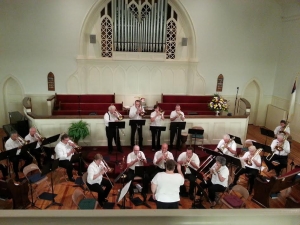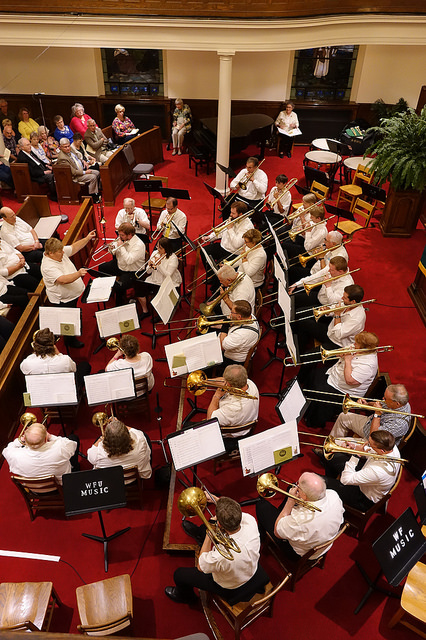Moravian
Trombone Choir
The Moravian Trombone Choir / (Posaunenchor, in German)

- Overview of the Moravian use of Trombone Choir, shared with the permission of Mike Allsen with links to his website.
- Timeline by Will Kimball of the appearances of trombone usage throughout history with many Moravian references.
Emmaus Trombone Choir
Moravian Trombone Choir Music: Frequently-Asked Questions
last update 9/15/15 http://allsenmusic.com/PosaunenchorFAQ.html
What is the traditional role of the Trombone Choir in Moravian worship?
Beginning in the early 18th century, Moravian settlements in America used the trombone choir (German: Posaunenchor) as a distinctive part of worship, though it is a practice that had its roots in centuries of Church tradition in Germany and Silesia. It is still a widely-popular tradition in Protestant churches in Germany, though these days Posaunenchor generally indicates a church brass band, rather than an all-trombone group: I recently heard a performance by a 25-member German Posaunenchor that only had one Posaune in the group! In 18th-century Moravian settlements, the trombone choir, playing from the church tower or from in front of the entrance, served to call the congregation to worship, and served as the congregation’s “portable” ensemble for accompanying outdoor services: burial services and the Easter sunrise service traditionally held in the graveyard adjacent to the church. The Posaunenchor would also announce deaths in the community (see below) and generally serve as the settlement’s “public address” system. There is a well-known story of an isolated settlement on the Ohio frontier that was about to be attacked by a band of Indians. The Posaunenchor, as the loudest sound available, played a chorale to sound the alarm; the Indians, hearing the “voice of God” were so shocked that they retreated without harming anyone. This story is probably apocryphal…but as a trombonist, I’ll have to admit that I like it.
Though trombone-only groups are relatively rare these days, nearly every congregation has an instrumental ensemble of some kind, even if it is a mixed band that meets once a year to play for the Easter sunrise service. The backbone of traditional Moravian instrumental music is a huge body of four-part chorales: many of them shared with other, younger Protestant denominations (especially the Lutherans and Methodists), but a large number of the traditional chorales are uniquely Moravian in origin and usage.

Trombone Choir
Forming a Posaunenchor
The “authentic” Moravian Posaunenchor is a full trombone “consort” comprised of Soprano, Alto, Tenor, and Bass (SATB) trombones. Sopranos, pitched in B-flat, are essentially identical to slide trumpets.
Any tuning adjustments that are an advantage with the normal tenor/bass trombone may be problematic and multiplied several times by the smallness of the soprano. What is a slight tuning adjustment on a tenor, say 1/4 inch of movement on the slide, becomes almost a half step on the soprano! (this clarification added by Erik Salzwedel)
It can be a significant challenge to ask a trumpeter to take on the soprano trombone/slide trumpet.
Also, finding a “good” soprano instrument is tough. Kanstul in California still makes a full family of SATB trombones, plus contrabass, and they are very fine quality and sound. Bach and Conn manufactured slide trumpets decades ago–if you can latch on to one of these old instruments, it will probably be serviceable. The German maker Mirafone still manufactures a “high end” soprano as well. The American makers LA Horn and Jupiter also manufacture slide trumpets which are fairly cheap, but you pretty much get what you pay for: these are instruments cobbled together with components from various drum corps and marching band horns. They can certainly be made to work, though, if you have a trumpet player with a good ear and a lot of patience. There is also a recently-issued soprano by Weril, a Brazilian maker (distributed by DEG), but I can’t really comment on this horn as yet.
Altos are, of course, much more common, and there are several modern makers. You can also buy altos on the cheap from Jupiter–see comments above. Most altos are pitched in E-flat, though it’s also fairly common to find instruments in F. My preference is for an E-flat Alto, which seems to blend a bit better with the B-flat instruments that make up the rest of the group, and which seems to have fewer intonation problems in general than the F Altos.
Tenors should be no problem at all: we’re talking about your normal garden-variety B-flat tenor trombone here.
In the early Moravian settlements, the bass voice was taken by a “true” bass pitched in F or E-flat–the sort of instrument that–like bass sackbuts–needed a hinged stick to reach the lower positions. These are virtually unknown today (though a few of the older Moravian congregations still own examples) and a modern bass trombone (with single or double triggers) is perfectly appropriate. Where a large-bore bass is unavailable, try at the very least to have the larger tenors (with single trigger) on the bass line. If you’re lucky enough to have access to a contrabass trombone and someone who can play it, it can effectively double the bass voice 8ba (tuba range). One of my fondest musical memories is playing in a 40-piece Posaunenchor that included two contras. The same effect can be approximated if you have a decent bass trombonist who can take the bass line down, but make sure he/she balances with the rest of the ensemble.
See Also https://de.wikipedia.org/wiki/Posaunenchor\
See Also http://kimballtrombone.com/2009/06/17/trombone-history-moravian-trombone-choir/
How can I arrange hymns for my group?
Of course the easiest solution is to have players who can read directly from the hymnal! However, since most church groups include less experienced players, you will need to produce transposed parts for standard four-voice hymn settings. This is of course easily done if you’re using Finale or some similar music processing program, but for those of you who are still using good old manuscript paper, I offer the following quick and easy guide to writing out parts for the most common brass instruments:
Soprano trombone or trumpet: These instruments will work well on the soprano and alto parts of most Protestant hymns. Experienced trumpet players will be perfectly happy in C (concert key), reading directly from the hymnal or a part copied directly from the hymnal. However, the majority of players will probably need a B-flat part. To do this, you need to do two things: 1) Change the key signature on the transposed part: add two sharps or subtract two flats. So a hymn in the key of D Major (two sharps) will be presented in E Major (four sharps), B-flat Major (two flats) becomes C Major (no flats or sharps), etc. 2) Write the entire line a whole step higher. Be aware that accidentals may change. So, for example, an E-natural in the key of B-flat Major will become an F-sharp in the transposed part.alto trombone or horn: These instruments are most appropriate for the alto part, but can also be substituted in on the tenor part as well. Experienced alto trombonists or hornists will probably be comfortable reading in C, and trombonists will usually be able to read a part written in alto clef, but it is much more common for players to read F parts. To do this, you need to do two things: 1) Change the key signature on the transposed part: add one sharp or subtract one flat. So a hymn in the key of F Major (one flat) will be presented in C Major (no flats or sharps), and a Hymn in C Major will be presented in G Major (one sharp), etc. 2) Write the entire line a perfect fifth higher.
E-flat parts: Not very common these days, but if you have older players, or someone with an alto horn, you may need to produce an E-flat part. To do this, you need to do two things: 1) Change the key signature on the transposed part: add three sharps or subtract three flats. So a hymn in the key of B-flat Major (two flats) will be presented in G Major (one sharp), and a Hymn in C Major (no flats or sharps) will be presented in A Major (three sharps), etc. 2) Write the entire line a major sixth higher.
Tenor and bass trombone or baritone/euphonium: These instruments are most appropriate for the tenor and bass parts, and for the most part can read bass clef parts copied directly from the hymnal. If you are copying something from a choral score, the tenor part will usually be presented in treble clef, written an octave higher than the sounding pitch. Experienced players will be able to read this, but usually you’ll need to copy such parts out in bass clef. It is common in trombone music to put higher parts in tenor clef, avoiding all those ledger lines, but this will be a problem for the majority of church band trombonists, so better stick with bass clef. You may occasionally have a baritone player who needs a B-flat part. In this case, transpose the part up an octave into treble clef, and follow the instructions given above for “soprano trombone or trumpet.”
Contrabass trombone or tuba: These instruments are appropriate for the bass line, and if you have someone else on the bass line, are most effective doubling the bass part an octave lower. You may need to write out thse 8ba parts for less experienced tuba players.
Jeff Reynolds conducts.
Trombones (Posaunen) in the Moravian Church
History timeline by Will Kimball with numerous references to trombones in Moravian congregations in Europe and America. See the years of 1731, 1755, 1757, 1761, 1763, 1765, 1767, 1770, 1771, 1781, 1782, 1783, 1785, 1792